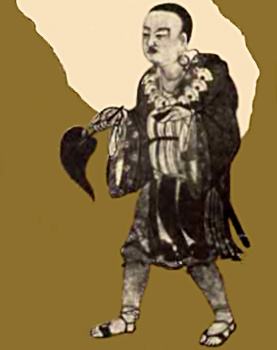|

Ghazipur to Vaishali
Leaving this country and going down the Ganges eastward 300 li or so, we come to the country of Chen-chu.
THE KINGDOM OF CHEN-CHU (GHAZIPUR)
This kingdom is about 2000 li in circuit; its capital, which borders on the Ganges river, is about 10 li in circuit. The people are wealthy and prosperous the towns and villages are close together. The soil is rich and fertile, and the land is regularly cultivated. The climate is soft and temperate, and the manners of the people are pure and honest. The disposition of the men is naturally fierce and excitable; they are believers both in heretical and true doctrine. There are some ten sangharamas with less than 1000 followers, who all study the doctrines of the Little Vehicle. (हीनयान)
Twenty Deva temples (Hindu temples at Ghazipur) There are twenty Deva temples, occupied by sectaries of different persuasions.
A stupa built by Ashoka-raja
In a sangharama(संघाराम) to the north-west of the capital is a stupa built by Ashoka-raja. The Indian tradition says this stupa contains a peck of the relics of Tathagata. Formerely, when the Lord of the World dwelt in this place, during seven days he preached the excellent law for the sake of an assembly of the Devas. Traces where the three Buddhas of the past age walked. Beside this place are traces where the three Buddhas of the past age walked and where they sat.
An image of Maitreya Bodhisattva (मैत्रेय बोधिसत्त्व)
Close by is an image of Maitreya Bodhisattva: although of small dimensions, its spiritual presence is great, and its divine power is exhibited from time to time in a mysterious manner.
Aviddhakarna’s (अविद्धकर्ण) sangharama (A convent)
Going east from the chief city about 200 li, we come to a sangharama called '0-pi-t'o-kie-la-na ("Ears not pierced" Aviddhakarna). The circuit (encircling wall) is not great, but the ornamental work of the building is very artistic. The lakes reflect the surrounding flowers, and the eaves of the towers and pavilions (or, the tower-pavilions) touch one another in a continuous line. The priests are grave and decorous, and all their duties are properly attended to.
The tradition states: Formerly there were two or three Sramanas, passionately fond of learning, which lived in the country of Tu-ho-lo (Tukhari), to the north of the Snowy Mountains, and were of one mind. Each day during the intervals of worship and reciting the scriptures, they talked together in this way: "The excellent principles of religion are dark and mysterious, not to be fathomed in careless talk. The sacred relics (traces) shine with their own peculiar splendor; let us go together from place to place, and tell our faithful (believing) friends what sacred relics we ourselves have seen."
On this the two or three associates, taking their religious staves, went forth to travel together. Arrived in India, at whatever convent gates they called, they were treated with disdain as belonging to a frontier country, and no one would take them in. They were exposed to the winds and the rains without, and within they suffered from hunger; their withered bodies and pallid faces showed their misery. At this time the king of the country in his wandering through the suburbs of the city saw these strange priests. Surprised, he asked them,
"What region, mendicant masters, come you from? and why are you here with your unpierced ears and your soiled garments?"
The Shramanas replied,
"We are men of the Tu-ho-lo country. Having received with respect the bequeathed doctrine, with high resolve we have spurned the common pursuits of life, and following the same plan, we have come to see and adore the sacred relics. But alas! for our little merit, all alike have cast us out; the Sramans of India deign not to give us shelter, and we would return to our own land, but we have not yet completed the round of our pilgrimage. Therefore, with much fatigue and troubled in heart, we follow on our way till we have finished our aim."
The king hearing these words, was much affected with pity, and forthwith erected on this fortunate (excellent) site a sangharama, and wrote on a linen scroll the following decree:
"It is by the divine favour of the three precious ones (Buddha, Dharma, Sangha) that I am sole ruler of the world and the most honoured among men. Having acquired sovereignty over men, this charge has been laid on me by Buddha, to protect and cherish all who wear the garments of religion (soiled or dyed garments). I have built this sangharama for the special entertainment of strangers. Let no priest with pierced ears ever dwell in this convent of mine." Because of this circumstance the place received its name.
Mahasara (महासर) (the present Masadh)
Going south-east from the convent of '0-pi-t'o-kie-la-na about 100 li, and passing to the south of the Ganges, we come to the town Mo-ho-sa-lo (Mahasara), the inhabitants of which are all Brahmans, and do not respect the law of Buddha. Seeing the Shraman, they first inquired as to his studies, and ascertaining his profound knowledge, they then treated him with respect.
Narayana-deva’s temple(नारायणदेव-मन्दिर) (present Vishnu-temple, Chhapara)
On the north side of the Ganges there is a temple of (Na-lo-yen) Narayana-deva. Its balconies and storied towers are wonderfully sculptured and ornamented. The images of the Devas are wrought of stone with the highest art of man. Miraculous signs, difficult to explain, are manifested here.
A stupa built by Ashoka-raja
Going east from this temple 30 li or so, there is a stupa built by Ashoka-raja. The greater part (a great half) is buried in the earth. Before it is a stone pillar about 20 feet high, on the top of which is the figure of a lion. There is an inscription cut in it (i.e., the pillar) respecting the defeat of the evil spirits.
Formerly in this place there was some desert demons, who, relying on their great strength and (spiritual) capabilities, fed on the flesh and blood of men. They made havoc of men and did the utmost mischief. Tathagata, in pity to living creatures, who were deprived of their natural term of days, by his spiritual power converted the demons, and led them, from reverence to him (kwai i ez ), to accept the command against murder. The demons, receiving his instruction respectfully, saluted him (by the pradakshina). Moreover, they brought a stone, requesting Buddha to sit down, desiring to hear the excellent law (from his mouth), that they might learn how to conquer their thoughts and hold them-selves in check. From that time the disciples of the unbelievers have all endeavoured to remove the stone which the demons placed for a seat; but though 10,000 of them strove to do so, they would be unable to turn it. Leafy woods and clear lakes surround the foundation on the right and left, and men who approach the neighbourhood are unable to restrain a feeling of awe.
Many sangharamas
Not far from the spot where the demons were subdued there are many sangharamas, mostly in ruins, but there are still some priests, who all reverence the doctrine of the Great Vehicle.
A ruined stupa, Drona stupa (द्रोण-स्तूप)
Going south-east from this 100 li or so, we come to a ruined stupa, but still several tens of feet high. Formerly, after the Nirvana of Tathagata, the great kings of the eight countries divided his relics. The Brahman who meted out their several portions, smearing the inside of his pitcher with honey, after allotting them their shares, took the pitcher and returned to his country. He then scraped the remaining relics from the vessel, and raised over them a stupa, and in honour to the vessel (pitcher) he placed it also within the stupa, and hence the name (of Drona stupa) was given it. Afterwards Ashok-raja, opening (the stupa), took the relics and the pitcher, and in place of the old one built a great stupa. To this day, on festival occasions (fast-days), it emits a great light.
Going north-east from this, and crossing the Ganges, after travelling 140 or 150 li, we come to the country of Fei-she-li (Vaishali).
|
